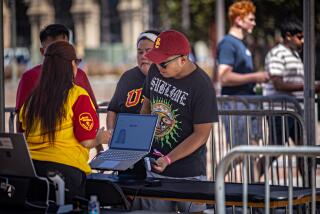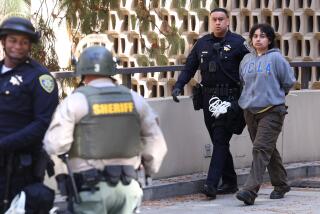Massive Student Walkout Spreads Across Southland
Nearly 40,000 students from across Southern California staged walkouts to protest proposed immigration legislation Monday, blocking traffic on four freeways and leaving educators concerned about how much longer the issue will disrupt schools.
The protests are believed to eclipse in size the demonstrations that occurred during the anti-Proposition 187 campaign in 1994 and even a famous student walkout for Chicano rights in 1968.
Some principals put their schools on lockdown Monday to keep students from leaving campus, and Los Angeles Unified School District officials said all middle and high schools will be on lockdown today.
Monday’s demonstrations appeared to start in Los Angeles but quickly spread to San Diego, Riverside, San Bernardino, Orange and Ventura counties. Though the protests were mostly peaceful, there were a few clashes and several arrests.
Motorists were left in gridlock as youths marched down Sunset Boulevard, Melrose Avenue, Laurel Canyon Boulevard and other major thoroughfares.
At one point, protesters marched onto the Hollywood Freeway in downtown Los Angeles and two sections of the Harbor Freeway, downtown and in San Pedro, briefly halting traffic.
Students in Orange County briefly blocked the Riverside Freeway and Santa Ana Freeway in Fullerton, waving Mexican flags and tossing a rock that smashed the window of a CHP cruiser.
By noon, thousands of youths had gathered in front of Los Angeles City Hall, with student leaders meeting privately with Mayor Antonio Villaraigosa. The rally took on a festive tone, with many waving Mexican flags and yelling, “Latinos Stand Up!” and “Viva Mexico!”
“It was my dad’s and grandfather’s sweat and tears that built the city of Los Angeles,” said Marshall High School senior Saul Corona, whose father came to the United States illegally before getting a green card. “People like them did things no one else wanted to do because they wanted me to have a better future.”
The protests appeared to be loosely organized, with students learning about them through mass e-mails, fliers, instant messages, cellphone calls and postings on myspace.com Web pages. By contrast, the massive rally Saturday that drew 500,000 people to downtown Los Angeles was highly organized, with demonstrators urged to wear white and bring American flags.
Many students said they were marching in opposition to a bill sponsored by Rep. F. James Sensenbrenner (R-Wis.) that passed the House in December. The bill would give police more power to enforce immigration law and would lead to 700 miles of additional fencing along the border.
Even as the students marched, a Senate committee approved an immigration package Monday that would enable some of the about 12 million undocumented immigrants in the country to become U.S. citizens.
As immigrants or children of immigrants, several marchers said they would be personally affected by Sensenbrenner’s pending bill.
“If this law passes, what will happen?” said Yadira Pech, 16. “There would be no more Los Angeles High School. Nearly all of us are immigrants.”
Added Antonio Chavez, an eighth-grader at University Heights Middle School in Riverside: “Our parents, our families came here from Mexico. We want other families to be able to come here too.”
Some students said they did not know exactly what the bill said but believed that it was part of an anti-immigrant movement taking hold nationwide.
“We just walked out because we didn’t want to be at school,” said Diana Hernandez, a senior at Dorsey High School in Los Angeles. “But we also believe [the legislation] is wrong.”
The demonstrations became violent in some areas. In San Diego County, two dozen protesters were arrested in Escondido after refusing orders from police to disperse. Two patrol cars were reportedly vandalized.
In Riverside, a peaceful student protest unfolded downtown as six youths and one adult were arrested across town after scuffles with police clad in riot gear and carrying nightsticks, authorities said. After following students throughout the city and calling for them to disperse, officers confronted the group. Students responded by hurling rocks and bottles at police.
“They’re pushing us around,” said Pati Sanchez, a Norte Vista High School senior. “People should be able to say what they think.”
In Santa Ana, officers used nightsticks and pepper spray to control students throwing bottles and rocks. They also set up barricades to prevent the protesters from disrupting traffic. One student was arrested and a few others suffered minor injuries, police said.
Four adults were arrested during a protest in Van Nuys, but no major violence occurred in Los Angeles County. The demonstrations prompted a tactical alert by Los Angeles police so the department could deploy officers to areas where they were needed.
“They’re noisy but well-behaved,” said LAPD Chief William J. Bratton as he walked through the downtown crowd. “Let them have their say.”
In a district with about 358,000 middle and high school students, an estimated 26,000 walked out of more than 50 Los Angeles Unified campuses. Teachers, principals and school police urged students to demonstrate on campus, but students flooded through gates and onto city streets and sidewalks.
“It’s very disruptive,” said Ellen Morgan, a spokeswoman for the Los Angeles Unified School District. “We want them to express their opinions, but there are venues, there are forums for them to do so. We’d like them to stay in school and get an education.”
Not only did the mostly high school students miss class time, administrators said, but the district could lose money if students did not show up. And with postings on myspace.com promoting more walkouts today, principals were doing whatever they could to encourage students to stay on school grounds.
All L.A. Unified middle and high schools will be on lockdown today, which means no one will be allowed to leave school once they enter, officials said. The district plans more stringent measures this morning, prohibiting students from going from class to class as usual.
Teachers are planning lessons on the immigration issue, and administrators are setting aside spots on campus for rallies and sit-ins. Some school officials plan to punish students who left campus with enforced attendance at Saturday school.
In Los Angeles, principals sent notes home that urged parents to tell their children to stay on campus and warned of disciplinary action for those who did not.
On Monday, some principals locked down their campuses in an attempt to prevent students from leaving school grounds. Nevertheless, students from at least one campus climbed over a fence to leave.
Lucy Delgadillo, whose children attend South East High School in South Gate, said she knows that lockdowns promote school safety.
“There are some kids who don’t know what the protest is about,” she said. “But there are kids who understand and feel strongly about this, and I think they should be allowed to protest.”
At some campuses where students did walk out, staff members marched alongside the youths to ensure their safety, officials said. In addition, Los Angeles school administrators dispatched about 30 buses to City Hall and other locations to ferry students back to their campuses in the afternoon.
In a noontime speech outside City Hall, Villaraigosa told the students that he opposed the Sensenbrenner bill.
“I know that all of you are fearful about what’s going on,” Villaraigosa said, referring to the pending legislation. “I know it would criminalize 12 million people.”
But later in the afternoon, when he came out to tell students to go home, he was met with chants of, “Hell no, we won’t go.”
Administrators expressed differing views on the protests, which took place on the Cesar Chavez holiday. Some complained about a wasted day, while others praised the youths’ activism.
“What pleases me is that our kids are politically active,” said Ventura Unified School District Supt. Trudy Arriaga. “Isn’t that what we want for the future?”
But Oxnard Union High School District Supt. Joy Dunlap said she hoped that it was over and that students had fulfilled their need to express their opinions.
“They’ve had that opportunity and now they’ll come back and get back to studies on a normal basis,” she said.
Santa Ana Unified School District Supt. Al Mijares said the students should use the classroom to engage in the immigration debate.
“The students are generally interested in the subject,” he said. “But our quest is to make sure they’re safe. We don’t want them to miss school.”
For the most part, students were met with support from honking motorists and cheering observers. (The demonstrations occurred a week after HBO premiered a movie about the 1968 student walkouts in East Los Angeles to protest the treatment of Chicanos.)
“I’m so proud of these kids,” said social worker Robin Sheiner, as she watched the crowd pass on Melrose. “They’re showing what they believe in.”
Times staff writers Hemmy So, Juliet Chung, Jennifer Delson, Gregory W. Griggs, Stephen Clark, H.G. Reza, Sara Lin, Kelly Anne Suarez, Michelle Keller, Tony Perry, Joel Rubin, Carla Rivera, Jessica Garrison, Mai Tran, Susannah Rosenblatt, Andrew Blankstein and Richard Winton contributed to this report.
More to Read
Sign up for Essential California
The most important California stories and recommendations in your inbox every morning.
You may occasionally receive promotional content from the Los Angeles Times.










